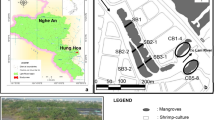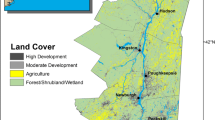Abstract
Natural populations ofG. asiatica Zhang & Xia andG. lemaneiformis (Bory) Weber van Bosse were studied during 1984 and 1986 in Zhanshan Bay, Qingdao (36°4'N, 120° 21'E). Rapid growth (length, weight) of these plants occurred between mid-May and late June (water temperatures, 15–20°C). The major epiphyte ofG. asiatica wasEnteromorpha linza, whilePunctaria latifolia was the major epiphyte ofG. lemaneiformis. Epiphytism declined throughout early summer, and epiphytes were rare after mid-July (1984); they did not reappear in late summer, although macrophyte growth declined abruptly after early July. Populations ofG. asiatica varied during late spring-early summer between adjacent sandy and rocky portions of the intertidal zone; plants at the sandy site were larger and epiphyte-free. Amphipod densities were low on both species ofGracilaria, but the most abundant species wereAmpithoe lacertosa, Caprella equilibra, C. krøyeri, C. scauraandPontogeneia rostrata. Additional information on general community structure is provided for theG. asiatica zone.
Similar content being viewed by others
References
Brawley, S.H. and W.H. Adey, 1981. The effect of micrograzers on algal community structure in a coral reef microcosm.Mar. Biol. 61: 167–77.
Cattaneo, A., 1983. Grazing on epiphytes.Limnol. Oceanogr. 28: 124–132.
Chapman, V.J. and D.J. Chapman, 1980. Seaweeds and Their Uses (3rd ed.) Chapman & Hall, London, 334 pp.
D'Antonio, C, 1985. Epiphytes on the rocky intertidal red algaRhodomela larix (Turner) C. Agardh: Negative effects on the host and food for herbivores?J. Exp. Mar. Biol. Ecol. 86: 197–218.
Edgar, G.J., 1983. The ecology of southeast Tasmanian phytal animal communities. IV. Factors affecting the distribution of ampithoid amphipods among algae.J. Exp. Mar. Biol. Ecol. 70: 205–225.
Filion-Myklebust, C. and T. Norton, 1981. Epidermis shedding in the brown seaweedAscophyllum nodosum (L.) Le Jolis, and its ecological significance.Mar. Biol. Letters 2: 45–51.
Harrison, P.G. and C.D. Durance, 1985. Reductions in photosynthetic carbon uptake in epiphytic diatoms by water-soluble extracts of leaves ofZostera marina.Mar. Biol. 90: 117–19.
Hruby, T. and T. Norton, 1979. Algal colonization on rocky shores in the Firth of Clyde.J. of Ecol. 67: 65–77.
Kangas, P., H. Autio, G. Hallfors, H. Luther, A. Niemi and H. Salemaa, 1982. A general model of the decline ofFucus vesiculosus at Tvärminne, south coast of Finland in 1977–81.Acta Bot. Fennica 118: 1–27.
Lubchenco, J. 1983.Littorina andFucus: Effects of herbivores, substratum heterogeneity, and plant escapes during succession.Ecology 64: 1116–1123.
Moss, B.L., 1982. The control of epiphytes byHalidrys siliquosa (L.) Lyngb. (phaeophyta, Cystoseiraceae).Phycologia 21: 185–88.
Robles, C.D. and J. Cubit, 1981. Influence of biotic factors in an upper intertidal community: Dipteran larvae grazing on algae.Ecology 62: 1536–47.
Sand-Jensen, K., N.P. Revsbech and B. Barker Jorgensen, 1985. Microprofiles of oxygen in epiphyte communities on submerged macrophytes.Mar. Biol. 89: 55–62.
Shacklock, P.F. and G.B. Croft, 1981. Effect of grazers onChondrus crispus in culture.Aquacult. 22: 331–42.
Shacklock, P.F. and R.W. Doyle, 1983. Control of epiphytes in seaweed cultures using grazers.Aquacult. 31: 141–151.
Sieburth, J. and J. Conover, 1966. Antifouling inSargassum natans: Recognition of tannin activity.Proc. Int. Seaweed Symp.5: 207.
Sieburth, J. and J.L. Tootle, 1981. Seasonality of microbial fouling onAscophyllum nodosum (L.) Lejol.,Fucus vesiculosus L.,Polysiphonia lanosa (L.) Tandy andChondrus crispus Stackh.J. Phycol. 17: 57–64.
Sousa, W.P., 1979. Experimental investigations of disturbance and ecological succession in a rocky intertidal algal community.Ecol. Monogr. 49: 227–254.
Tseng, C.K., 1981. Commercial cultivation.In: The Biology of Seaweeds (C.S. Lobban and M.J. Wynne, eds.) Oxford: Blackwell Scientific, pp. 680–725.
Waaland, J., 1981. Commercial utilization.In: The Biology of Seaweeds (C.S. Lobban and M.J. Wynne, eds.) Oxford: Blackwell Scientific, pp. 726–742.
Warwick, R.M., J.T. Davey, J.M. Gee and C.L. George, 1982. Faunistic control ofEnteromorpha blooms: A field experiment.J. Exp. Mar. Biol. Ecol. 56: 23–31.
Author information
Authors and Affiliations
Additional information
Contribution No. 1407 from Institute of Oceanology, Academia Sinica.
Rights and permissions
About this article
Cite this article
Brawley, S.H., Xiugeng, F. Ecological studies ofGracilaria asiatica andGracilaria lemaneiformis in Zhanshan Bay, Qingdao. Chin. J. Ocean. Limnol. 6, 22–34 (1988). https://doi.org/10.1007/BF02846565
Received:
Issue Date:
DOI: https://doi.org/10.1007/BF02846565




